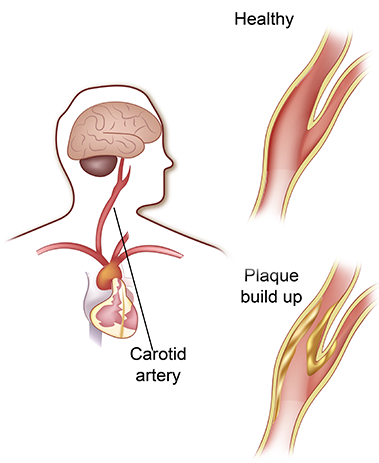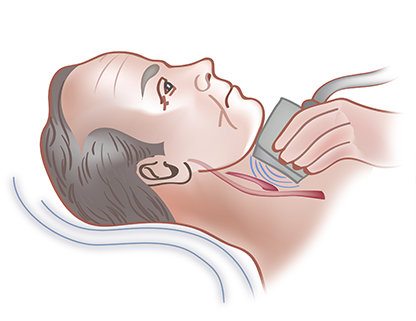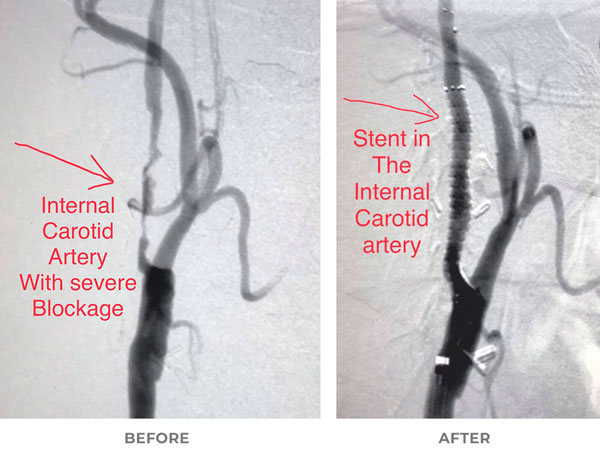What is carotid artery disease and what are the causes?

The carotid artery is one of the main blood vessels supplying blood to the brain. Plaque buildup may occur causing an obstruction usually in the mid portion of the neck. This plaque buildup may be caused by several risk factors for blood vessel disease. Family history is an important component, as is smoking cigarettes, high cholesterol, high blood pressure, and diabetes.
What are the symptoms?
Carotid artery disease may be present without symptoms. When it produces symptoms, patients may experience sudden visual loss, troubles with speech, or weakness or numbness of one side of the body. If these symptoms occur and then resolve within 24 hours of their onset, it is called a transient ischemic attack (TIA). If the symptoms do not resolve it is a stroke. Patients experiencing any of the above symptoms should immediately call 911.
How is carotid artery disease diagnosed?

Your physician may listen to your neck with a stethoscope and hear the sound of an abnormal flow of blood called a bruit which could indicate carotid disease. Unfortunately the physical exam alone is not very sensitive for carotid disease. The first test usually performed if a patient experiences symptoms or there is a high suspicion for disease is a carotid artery ultrasound. This is an excellent non- invasive way to determine whether a patient has carotid artery disease. This can often be performed in our office. If the disease is severe enough to require treatment, a CT scan with contrast given through an IV or an MRI also usually with contrast is done to confirm the diagnosis and for operative planning. A simple lab test is required prior to the CT scan or MRI examination.
How is carotid artery disease treated?
Depending on the severity and the symptoms carotid artery disease may be either closely followed or treated with surgery or stenting. If the plaque buildup is not severe and there are no symptoms your carotid blockage may be followed to make sure that it doesn't worsen. We know thatin patients that have no symptoms, if the blockage is less than 60 to 70% there is a minimal risk of problems and patients can be safely monitored. During this process ultrasounds will be done every 6 to 12 months and it will be very important to modify all the risk factors that caused the problem including cholesterol, blood pressure, and diabetes control and smoking cessation.
Daily aspirin and cholesterol medication will be advised. Regular walking if possible 30 minutes daily at least 5 times a week is also very important.
If there are symptoms or if the blockage is severe, a procedure will likely be recommended to treat the blockage. A carotid surgery, called an endarterectomy, can be performed to remove the blocking plaque from the artery. An incision is made in the mid portion of the neck, the artery is controlled above and below the area of disease. A temporary shunt to provide blood flow to the brain during the procedure is placed if needed. The plaque is then removed and the artery is restored to its normal state as it was prior to the plaque formation. Since this artery is very superficial, it is the pulse you can feel on your neck, the surgery can be done with local anesthesia and a mild sedation or a general anesthesia. With both methods the recovery is quite rapid. Patients generally are discharged the day after the operation and recovery at home is about 2 weeks.

For patients who are high risk for surgery a stent can be inserted to open the artery from a puncture site in the groin. Both the surgery and the stent have a very low risk of stroke but the risk is slightly higher with the stent placement. Therefore, if a patient has low risk for surgery, surgical treatment is advised. If a patient is high risk either surgery under local anesthesia or the stent placement may be considered.
For all the patients undergoing carotid artery surgery, taking all medications including aspirin is advised, including the morning of the surgery. If you take Plavix, you may be asked to hold this medication for 5 days prior to surgery. Please check with your surgeon. For carotid stenting, all medications including Plavix should be taken, including the morning of the procedure.
For diabetic medications please ask your surgeon.
How is the recovery for carotid procedures?
With either the carotid surgery or stent discharge from the hospital often occurs the next day. As with any procedure it is advisable to have assistance for the first few days. But patients can function normally in day to day activities around the home. Monitoring of the carotid artery will be performed at 3 months and then every 6 to 12 months for life with ultrasound to ensure that the repair is durable. Because during surgery the carotid artery is closed with a small patch and during stenting the stent remains in contact with the circulation, antibiotic prophylaxis is advised prior to any invasive procedure, including dental procedures.